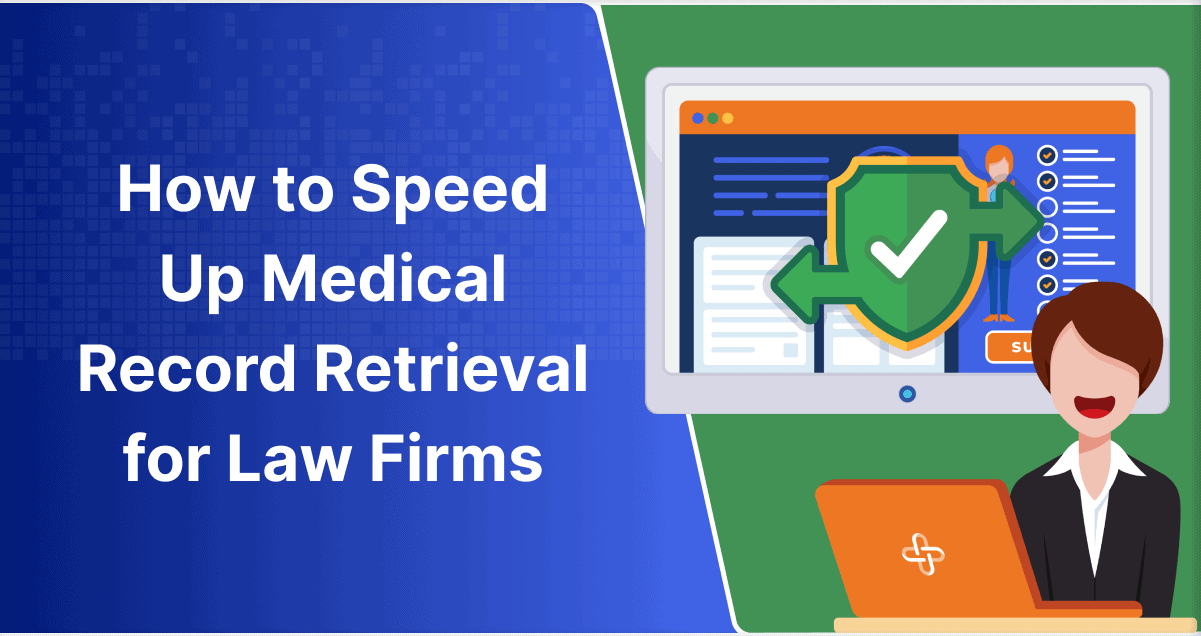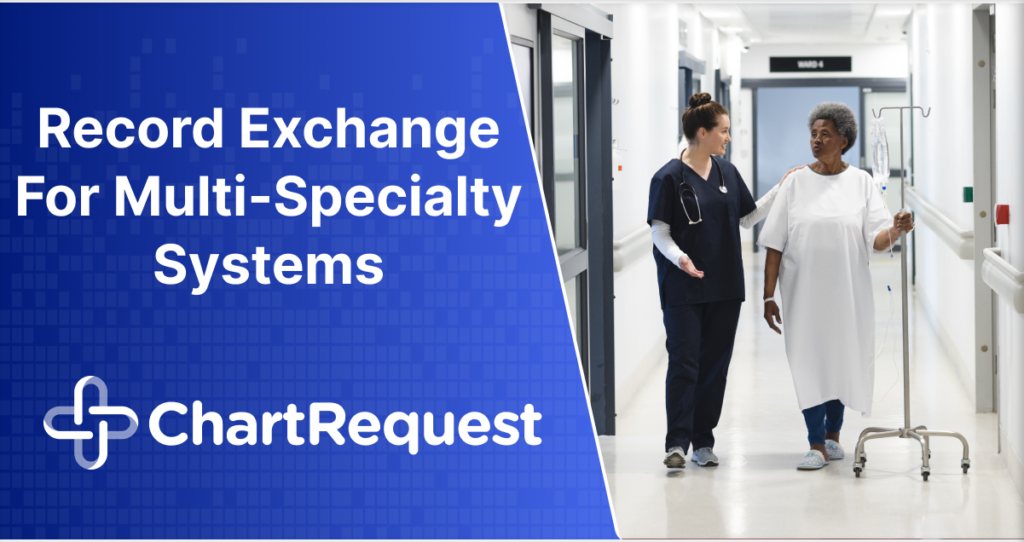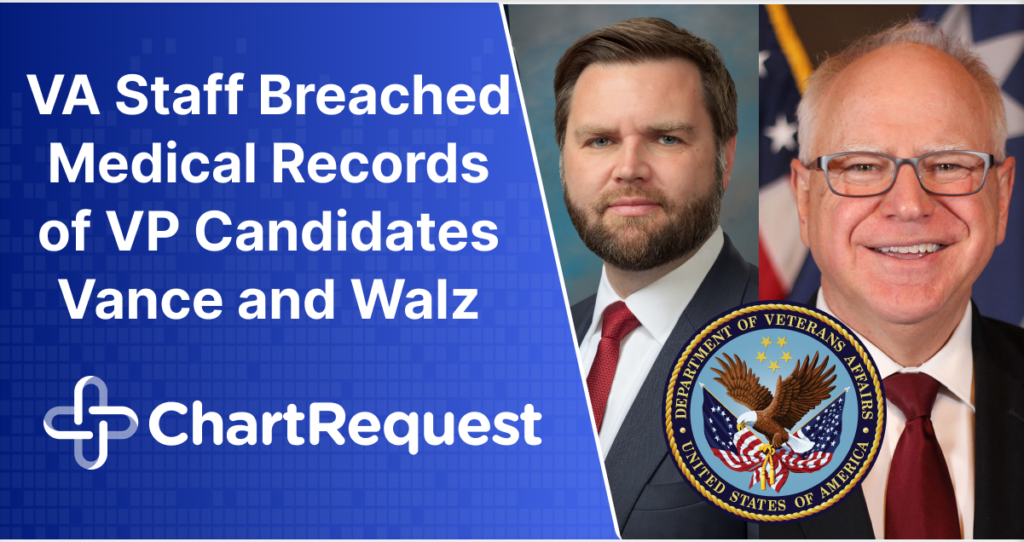Time is of the essence — a phrase we are all too familiar with in personal injury law. You may wonder, “How can law firms speed up the medical record retrieval process?”
The fast-paced nature of client demands and medical record requests emphasizes the importance of simplifying your legal team’s operational tasks.
As the lifeblood of personal injury investigations, medical records can significantly influence the outcomes of legal disputes. Still, even the most formidable legal team experiences obstacles when trying to access these critical documents.
Streamlining your office procedures is essential for improved client relations and efficiency. At ChartRequest, we created a comprehensive guide tailor-made for personal injury attorneys and paralegals seeking to optimize their medical record retrieval process.
We will help you transform the complex task of securing medical records into a streamlined, efficient, and formidable component for your legal practice.
Understanding the Medical Record Retrieval Process
Medical records generally include a wide range of details that may impact the validity of your case, including:
- Proof of your client’s identification and treatment
- Approximate date and time of injuries
- Formal diagnoses and doctor’s annotations
- The severity of your client’s injuries
- Estimated treatment time
- Treatment outcomes and amendments
- Your client’s cooperation with health advice
- And more
It’s crucial to understand the various phases of medical record exchange and the retrieval roles of each participant in your firm. The primary stages include request initiation, approval, payment, and release.
What Are Medical Record Requests
The attorney or paralegal, often acting on behalf of their clients, initiates the retrieval process by submitting a request to an authorized custodian. Healthcare providers may maintain physical records in-house or keep digitized copies in a secure cloud network.
Sometimes, storage and staffing limitations prevent physicians from managing records alone. In this case, they may partner with a third-party custodian who provides transfer and use services. Knowing which custodian to contact will help you hasten the medical record retrieval process.
According to HIPAA rules and regulations, custodians must respond to record requests within 30 days or may be subject to financial penalties. However, if your client’s case moves quickly, you may need these documents sooner. Investing in a third-party record exchange platform — like ChartRequest — is practical to free up staff from handling frequent communication and updates between multiple parties.
1: Approving Record Requests
How can law firms speed up the medical record retrieval process if most requests fall in the hands of custodians?
Custodians must review, verify, and approve every medical record request from legal professionals they receive. The approval process can take time and requires significant attention to detail. Consequently, delays may prevent you from accessing the needed records even if you qualify to receive them.
Laws restrict access rights to medical records. However, patients always have the right to request their medical records for any reason. As their legal representative, you may also have the right to request this information on their behalf.
The custodian must verify that you or your client’s credentials match their database before they can issue a release of information (ROI). To complete this task, they must check the:
- Patient’s name
- Patient’s date of birth
- Date of the request
- Type of record requested
- Other relevant personal information
- Valid patient signature
Custodians can deny a request if they receive the wrong verifying information from your legal team. In this case, you may be able to appeal or resend the information. This method may delay your request by several days.
2: The Billing Process
Custodians will forward approved medical record requests to billing. Once an employee processes the payment, the medical provider releases the records — typically with a long turnaround time.
A single medical record request takes several hours to review, process, and complete. The custodian will provide a detailed receipt of your request and transaction, including timestamps for the service date.
3: The Release of Information
Upon receiving your transfer receipt, confirming that your records are complete and legible is essential. Do not wait too long to verify this information, or you risk further delaying your case.
Custodians may inadequately fulfill requests, delay approvals, or experience stalls due to billing quagmires. Alternatively, the provider may lose the request in this shuffle altogether.
Without an organized retrieval mechanism, these bottlenecks can snowball into significant headaches for your team.
Why Should Law Firms Speed Up Medical Record Retrieval?
How can law firms speed up the medical record retrieval process and how does timely delivery impact a client’s case?
Speedy record exchange is pivotal in the legal sector because strict statute limitations often govern the window for filing a personal injury or medical malpractice claim. Missing critical deadlines is a significant threat that can result in dismissing an otherwise legitimate and potentially winnable case. The odds of these mishaps occurring increase if you cannot acquire pertinent medical records on time.
The ability to rapidly access and analyze these documents enables attorneys to assess the merits of a case accurately and advise their clients accordingly. A fast ROI solution can help you navigate your client through complex legal structures and enhance their knowledge and experience along the way.
An expedited medical record retrieval process can also elevate your attorney-client relationship, building trust and demonstrating professional efficiency. Clients feel valued and reassured when they witness their legal representatives acquiring necessary documentation with urgency and diligence.
This strategy can prove crucial, particularly in personal injury cases, where the client’s financial recovery and well-being can hinge on the prompt settlement of their legal matter.
How Can Your Law Firm Avoid Delays During Medical Record Retrieval?
We’ve mentioned how administrative setbacks could delay your law firm’s medical record retrieval process. Let’s dive deeper into these technicalities to help you better understand issues related to traditional information requests.
Identifying these characteristics can empower your legal team to develop strategies for mitigating waiting times and optimizing workflow efficiency.
Prioritize Proper Time Management
Improper time management can drastically hinder the medical record retrieval process. Legal teams might not prioritize record requests or fail to follow up in a timely fashion, underscoring the necessity for:
- Practical Planning: Develop a standardized timeline for follow-ups to ensure that custodians are processing requests. Don’t wait until the last minute to request information if your case deadlines are coming up.
- Task Delegation: Assign specific team members to oversee the tracking of medical record retrieval statuses. Paralegals typically contact healthcare providers, insurance companies, and other custodians for these requests. However, other attorneys may need to complete these tasks if paralegals do not have the proper training or authorization.
- Monitoring: Keeping track of your request as the days pass is essential. You may need to contact several vendors for dozens of requests, making monitoring documents challenging. A third-party service like ChartRequest can centralize these tasks to help your law firm achieve the quickest turnaround times possible.
Provide Top-Notch Training
When asking, “How can law firms speed up the medical record retrieval process?” consider your team’s training. Legal staff may encounter avoidable challenges due to insufficient experience. It is essential to:
- Invest in Top-Notch Training: Ensure staff members comprehensively understand medical record retrieval’s legal and administrative aspects. These courses should reinforce company security policies, time management, contingency plans during delays, and more.
- Consider Regular Updates: ROI platforms and procedures change all the time. Keep training current with the latest industry standards and legal requirements. This strategy also ensures that your law firm complies with HIPAA standards and other government guidelines.
- Balance Workload Consistency: Specific members of your law firm may be unable to handle most (if not all) of the medical record request process. While it is important to designate these tasks to those who can complete them promptly, others on the team may still require adequate training if they interact with these steps at any level.
Understand Medical Record Request Bottlenecks
Bottlenecks often occur when multiple requests converge upon a single point without sufficient processing capacity, leading to:
- Queue Management Issues: Implement a system to manage the queue of pending requests. Most third-party record exchange companies — like ChartRequest — will provide quality solutions for high-volume requests.
- Assessment and Refinement Mitigation: Regularly assess bottlenecks and refine processes to maintain swift retrieval flow. The more clients your law firm earns, the more requests you should expect to process.
- Confusion: Overwhelming employees with high-volume record requests can confuse them and reduce productivity. Keep morale up in your office by proactively planning for bulk requests before they slow you down.
Prevent Communication Breakdowns
Failures in communication between the legal team and medical providers or within the team itself can cause significant delays. These problems may spiral out of control via:
- Unclear Protocols: Create clear communication protocols and chains of command. You can achieve this result during the ROI training period. However, ensure everyone has the tools to send and receive messages promptly.
- Missing Feedback Loops: Establish a feedback loop to address and correct miscommunications promptly. You can support these procedures using integrated internal communication software or other law firm-enhancing products.
- Disgruntled Employees: Prioritize your employees’ happiness to prevent low morale from harming your ROI procedures. Studies show that many paralegals experience burnout due to heavy workloads and poor in-office communication. Reducing stress in your law firm is an excellent way to streamline the process.
Correct Any Unverifiable Information
How can law firms speed up the medical record retrieval process if custodians deny their requests? Requests containing errors or unverifiable data are set aside by healthcare providers, necessitating:
- Accuracy Checks: Rigorous checks for accuracy of client information before submission. Some providers may utilize artificial intelligence tools to address multiple documents simultaneously. However, these tools can make mistakes and delay the process without proper attention to detail.
- Quality Control: Implement quality control measures to reduce the likelihood of errors upon request. This practice helps healthcare providers and custodians identify your credentials quickly and approve medical record releases without additional steps.
- Frequent Updates: You can always contact your clients’ healthcare providers at any point during the ROI journey. Asking for updates is a practical way to reduce concerns and identify a timeline to work your case around.
Security Breaches
A compromised law firm network can halt the retrieval process. Thousands of hacks, malware, and surprise shutdowns occur to legal professionals and healthcare facilities every year. Hence, it is paramount to scale your cybersecurity infrastructure and monitor risks:
- Robust Security Measures: Employ stringent data protection protocols to safeguard sensitive information. This process will protect you from costly HIPAA violations that may expose your clients’ protected health information.
- Risk Management: Regularly review and update security policies to mitigate risks of breaches. You should leverage your law firm’s IT department for these tasks. Specific factors may impact some law offices but not yours. Personalizing your security and compliance procedures will ensure the best results.
- Outsource Your Requests: ChartRequest’s HITRUST encrypted database offers a secure way to request and transfer sensitive data without worry. This solution will allow you to focus on other cybersecurity tasks without interrupting your law firm from receiving client medical charts.
Ease Technology Learning Curves
Introducing new technology to expedite retrievals can initially slow down the process due to learning curves, requiring:
- Phased Implementation: Roll out new technology in phases to allow staff time to adapt. Implementation could take several days to several months to complete, depending on the size of your firm. Still, training your paralegals and assistants on new technology may not be practical if your operations already require a significant workforce — investing in a hands-off solution may resolve these concerns.
- Support Resources: Provide ample resources and support for technology adoption. However, purchasing more technology for your office may be costly and require more attention. Consider investing in ChartRequest to provide superior support for all your record request needs.
- Updated Networks: Update your technology with new plugins, software, or system improvements. This practice reduces exploits in your network and safeguards client information upon arrival.
How to Streamline Coordination With Healthcare Providers
ROI inefficiencies often expose themselves during initial interactions between legal representatives and healthcare institutions. Here lies a significant opportunity to improve your experience by employing effective communication strategies.
1. Follow Polished Medical Record Request Protocols
Some personal injury attorneys wonder, “How can law firms speed up the medical record retrieval process with updated request protocols?”
Crafting meticulous and error-free record requests is the first step toward seamless communication. Ensure that requests are comprehensive, clear, and legally sound, sparing neither detail nor citation. A proper request minimizes back-and-forth between the requestor and custodian — increasing the likelihood of speedy approval and fulfillment.
Knowing which questions to ask during requests can help you speed through the process without missing vital information.
2. Develop Personnel Partnering
Cultivating a professional rapport with designated provider representatives can expedite retrievals. Designate a point person within the allied medical institution with whom you can consistently correspond. This peer-to-peer relationship can manifest in prioritized requests and alerts for incoming documentation.
It’s common for personal injury attorneys to build professional relationships with multiple healthcare institutions throughout their careers. In some instances, attorneys may need to contact numerous providers on behalf of a client during a single case.
3. Implement Technology Enhancements
Embrace secure and robust healthcare communication technologies tailored to the legal niche. Encrypted email and secure web portals can eliminate the security protocol lag that often clings to outdated communication channels. These modern solutions reduce compliance violations and ensure that only authorized personnel receive client medical information after approval.
Leveraging Technology Solutions
The proliferation of technology in the healthcare domain presents a silver bullet for unauthorized users and delays that erode retrieval efficiency. Here are a few implementations you should consider for your law firm:
1: Electronic Health Records (EHR) Integration
The seamless transfer of records between EHR systems and legal databases drastically expedites medical record access. Collaboration with healthcare providers who use EHRs can simplify retrieval and delivery. Additionally, consideration of EHR interoperability and compatibility can amplify retrieval celerity.
Many attorneys prefer hardcopy documentation for their cases. However, waiting on physical medical chart copies can delay retrievals and skyrocket billable expenses.
2: Digital Request Platforms
Dedicated digital platforms that aggregate and streamline record requests across multiple facilities can be invaluable. These platforms standardize requests, track their progress, and even relay automated updates, diminishing the need for manual follow-ups.
In other words, you can access information from multiple vendors in one convenient location. Centralized medical record retrieval can save you hours building your case.
3: Medical Record Retrieval Management Software
Evolve beyond simple database storage to advanced retrieval management software. These tools organize and track requests and schedule and manage follow-ups — bringing herculean automation to the historically labor-intensive retrieval task.
Remember, your legal team may not have the time or energy to learn new technology. ChartRequest offers a Full-Service solution that handles software management duties on your behalf, freeing up your office staff from these burdensome responsibilities.
Navigating Legal and Regulatory Requirements
You may ask, “How can law firms speed up the medical record retrieval process if most requests are at the mercy of local and federal laws?”
The legal and regulatory context surrounding medical record retrieval is complex, with HIPAA as the primary marker for privacy considerations. Grasping these requirements ensures ethical and effective medical record retrieval processes.
Scrupulous HIPAA Compliance
Strict adherence to the HIPAA Privacy Rule is non-negotiable. Familiarize your team with its provisions, particularly regarding the Minimum Necessary Standard, patient rights, and safeguard protocols. Combining compliance with your request strategy fosters mutual respect and cooperation with healthcare providers.
Keeping an airtight seal on your firm’s compliance also helps avoid embarrassing disclosure violations that may cost you clients or discourage positive online reviews.
State and Federal Law
Each state sets laws and regulations governing the medical record retrieval process. A nuanced understanding of these regional idiosyncrasies is vital. Watch for emergent legislation influencing retrieval protocol and plan your ROI procedures accordingly.
How to Collaborate With Medical Record Retrieval Services
Outsourcing aspects of the retrieval process to specialized services is a strategic nod toward efficiency. In fact, many personal injury attorneys are making the switch to guarantee a smoother transfer of documentation during their investigations. Here are two factors to consider:
1: Third-Party Triumphs
Medical record retrieval services like ChartRequest dedicate themselves to helping law firms speed up and navigate the labyrinth of high-volume records requests. Selecting a reputable and experienced vendor can yield several benefits, from bulk request processing to accelerated retrieval velocity.
When seeking third-party support, be sure to partner with a top-rated software and services company to avoid unnecessary issues along the way.
2: Selecting Service Superstars
Prioritize experience, service range, and technological acumen when sifting through service providers. Transparency in pricing, quick sample record provisions, and robust security measures should be non-negotiable when vetting potential partners.
ChartRequest will provide answers to any questions you have during your initial consultation. You may require services that other law firms do not. In that case, a team of friendly product representatives will guide you toward solutions that meet your firm’s unique operational needs.
Best Practices for Organizing and Analyzing Medical Records
How can law firms speed up the medical record retrieval process after successfully obtaining the first batch of documents?
Collecting medical records is only useful if you can accurately assess and leverage the information provided. Below, we’ve listed some tips that will help you organize your case quickly after receiving the requested information:
1: Agile Organization
Develop a standardized system for organizing records deeply entrenched in chronological and thematic order. This system must be flexible enough to accommodate records from diverse medical disciplines and institutions.
2: Analyzing for Actionability
You require a distinct skill set to comb through records and extract actionable insights. This analysis should uncover key findings, timeline discrepancies, and medical assessments, preparing them as cogent ammunition in litigation.
3: Management Software Mastery
Enlist the aid of robust case management software that can categorize, synthesize, and annotate information inputs. These tools help translate vast medical data and legalese into logical, navigable reports.
4: Update Your Client
Now that you have everything you need — from requested medical records to documented insights — it’s time to update your client. Giving them an accurate investigation timeline and delivering a report of your findings is a great way to keep their spirits up throughout litigation.
In most cases, a speedy ROI experience will increase their likelihood of recommending your services to others in the future.
Why Choose ChartRequest for Your Legal ROI Procedures
The quest to speed up medical record retrieval is all-encompassing, leveraging technological, strategic, and regulatory considerations in personal injury law. By aligning with healthcare providers, harnessing digital solutions, and cultivating superior organizational practices, you can deliver the best results for your clients.
Fortunately, you don’t have to navigate the ROI experience alone. At ChartRequest, we make every step of the process easy with superior communication, secure technology, and a five-day turnaround guarantee for requests submitted to our Full-Service custodian partners.
Don’t just take our word for it — see what our other customers have to say about our product and services today. We put your needs first so you can be confident about case outcomes and meet the statute of limitations.
How can law firms speed up the medical record retrieval process? Learn more about how our Full-Service solution for law firms.









